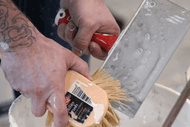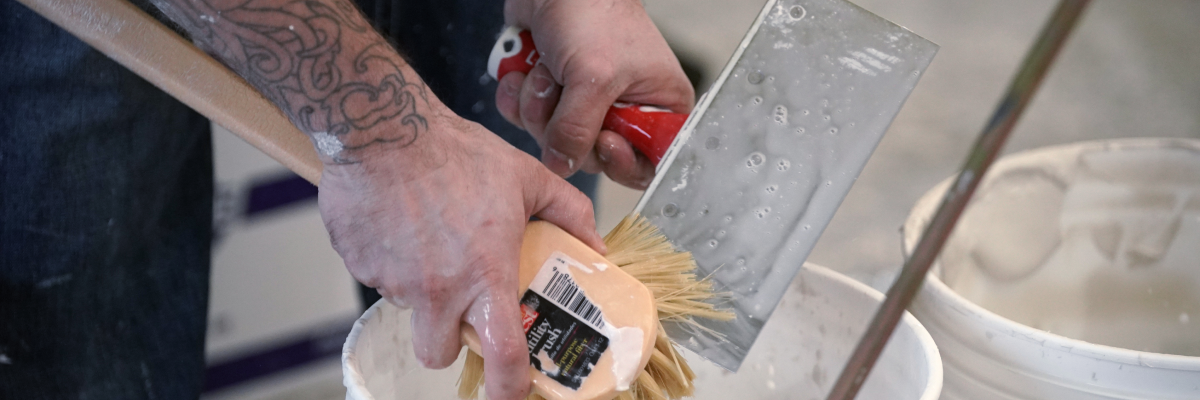How to Clean and Maintain Your Drywall Hand Tools
Author: LEVEL5 Tools
Publish Date: November 9, 2023
What are Drywall Hand Tools?
Drywall finishing hand tools range from joint knives, taping knives, trowels to hawks, compound mixers and pans. They are typically manufactured using stainless steel, or carbon steel that is then treated (such as blue steel) or plated for corrosion resistance.
Cleaning and maintaining your drywall finishing tools properly will help them last longer and perform better during their lifespan. With longer periods before replacement, the tools will also be more economical over the long run.
Below are recommendations on care and cleaning that will ensure you maximize their useful lifespan.
General Cleaning Technique
It is essential to clean all of your drywall hand tools thoroughly after each use to remove any lingering joint compound or debris and to prevent buildup over time. Start by removing any obvious residue from the blade and handle by wiping it down with a clean cloth. To remove any dried joint compound, soak the knives in warm water for a few minutes, or use a damp cloth. This will soften the compound so it can be dislodged.
Caring for Stainless Steel Blades
For many drywall finishing tools, the stainless steel is not the same as “marine grade” stainless which is very firm and brittle (and doesn’t hold an edge well). The stainless steel alloy often includes a higher amount of iron in it, which provides flex and better tool performance. This also means it may superficially oxidize/rust when in contact with water or wet drywall compound for extended periods of time (we’re talking days, not hours here).
For the longest life, we always recommend that all finishing tools with stainless steel blades be cleaned and dried thoroughly between uses. If you do see some superficial corrosion on a stainless steel blade, not to worry. Just wipe it off, or lightly sand it off. If sanding, we suggest using 220 grit or finer sandpaper. Be very careful - if you sand too aggressively, you may introduce grooves into the blade edge which can then appear on the surface of the compound.
Caring for Carbon Steel & Blue Steel Blades
Carbon steel and blue steel blades are often preferred by finishing professionals because they provide outstanding flex, feel and work-ability. However, unlike stainless steel, they will quickly oxidize/rust without proper care between uses.
We recommend that the knives be cleaned thoroughly then lightly coated with WD-40 or a similar product prior to storage. Having this coating on the blades will keep them from oxidizing between uses by acting as a barrier to any moisture in the air. The knives should also be placed upright while they are drying, to ensure water doesn't collect near the handle.
As an alternative option, we offer most of the same tool configurations with stainless steel blades for easier care and convenience (but with a slightly stiffer feel).
Below is a short video from Scott Murray, founder of LEVEL5 Tools with more info on how to care for your tools with carbon steel and blue steel blades:
Storage
Your drywall hand tools will serve you well for many more years if you store them properly. After washing, thoroughly dry the tools before putting them away. Rust and corrosion can form on tools if moisture is allowed to remain on them. Joint knives and taping knives should be stored upright (handle pointing up) so that any moisture can run down the shaft and out of the handle. In addition, keep your tools in a dry location, as moisture in the air can also lead to the formation of rust spots.
If you want to keep your drywall hand tools neat and easily accessible, we suggest you look into purchasing a tool storage system or a dedicated rack. These safeguards will reduce the likelihood of accidental chipping, bending or other damage to the blades and prolong their useful life. All LEVEL5 joint knives and taping knives feature extra large hand holes to aid in convenient storage on pegboard, if that is your preference.
Learn More
To learn more about the wide range of hand finishing tools available from LEVEL5, visit the catalog. If you have any questions, comments or suggestions, we encourage you to give us a call, toll-free at 800.227.7713.
What are Drywall Hand Tools?
Drywall finishing hand tools range from joint knives, taping knives, trowels to hawks, compound mixers and pans. They are typically manufactured using stainless steel, or carbon steel that is then treated (such as blue steel) or plated for corrosion resistance.
Cleaning and maintaining your drywall finishing tools properly will help them last longer and perform better during their lifespan. With longer periods before replacement, the tools will also be more economical over the long run.
Below are recommendations on care and cleaning that will ensure you maximize their useful lifespan.
General Cleaning Technique
It is essential to clean all of your drywall hand tools thoroughly after each use to remove any lingering joint compound or debris and to prevent buildup over time. Start by removing any obvious residue from the blade and handle by wiping it down with a clean cloth. To remove any dried joint compound, soak the knives in warm water for a few minutes, or use a damp cloth. This will soften the compound so it can be dislodged.
Caring for Stainless Steel Blades
For many drywall finishing tools, the stainless steel is not the same as “marine grade” stainless which is very firm and brittle (and doesn’t hold an edge well). The stainless steel alloy often includes a higher amount of iron in it, which provides flex and better tool performance. This also means it may superficially oxidize/rust when in contact with water or wet drywall compound for extended periods of time (we’re talking days, not hours here).
For the longest life, we always recommend that all finishing tools with stainless steel blades be cleaned and dried thoroughly between uses. If you do see some superficial corrosion on a stainless steel blade, not to worry. Just wipe it off, or lightly sand it off. If sanding, we suggest using 220 grit or finer sandpaper. Be very careful - if you sand too aggressively, you may introduce grooves into the blade edge which can then appear on the surface of the compound.
Caring for Carbon Steel & Blue Steel Blades
Carbon steel and blue steel blades are often preferred by finishing professionals because they provide outstanding flex, feel and work-ability. However, unlike stainless steel, they will quickly oxidize/rust without proper care between uses.
We recommend that the knives be cleaned thoroughly then lightly coated with WD-40 or a similar product prior to storage. Having this coating on the blades will keep them from oxidizing between uses by acting as a barrier to any moisture in the air. The knives should also be placed upright while they are drying, to ensure water doesn't collect near the handle.
As an alternative option, we offer most of the same tool configurations with stainless steel blades for easier care and convenience (but with a slightly stiffer feel).
Below is a short video from Scott Murray, founder of LEVEL5 Tools with more info on how to care for your tools with carbon steel and blue steel blades:
Storage
Your drywall hand tools will serve you well for many more years if you store them properly. After washing, thoroughly dry the tools before putting them away. Rust and corrosion can form on tools if moisture is allowed to remain on them. Joint knives and taping knives should be stored upright (handle pointing up) so that any moisture can run down the shaft and out of the handle. In addition, keep your tools in a dry location, as moisture in the air can also lead to the formation of rust spots.
If you want to keep your drywall hand tools neat and easily accessible, we suggest you look into purchasing a tool storage system or a dedicated rack. These safeguards will reduce the likelihood of accidental chipping, bending or other damage to the blades and prolong their useful life. All LEVEL5 joint knives and taping knives feature extra large hand holes to aid in convenient storage on pegboard, if that is your preference.
Learn More
To learn more about the wide range of hand finishing tools available from LEVEL5, visit the catalog. If you have any questions, comments or suggestions, we encourage you to give us a call, toll-free at 800.227.7713.





